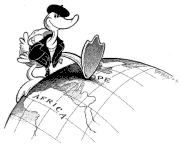11.11.06
Remembrance Day / Veteran's Day
November 11 is Remembrance Day in Canada and Veterans Day in the US. You would think they would be basically the same thing, but their observance has some significant differences.
Remembrance Day is a pretty big deal in Canada. It honors members of the armed forces who were killed during war — dead people. Remembrance Day is a government holiday, there are services on November 11 that many people go to, there are two minutes of silence at 11:11 (the time the WW1 Armistice was signed), and it is common for people wear poppies on their clothing on the day of (and before, and after). My husband and I have two poppies and wear them.
Veterans Day is not observed to the same degree. It honors war veterans — principally the living, with the dead remembered on Memorial Day. Veterans Day is a government holiday, but lots of businesses and schools stay open.
Perhaps Veterans Day is less of a big deal because veterans are living, breathing human beings with flaws and foibles, whose sacrifices varied wildly. If you happen to be acquainted with a veteran who you don’t like — maybe your uncle-in-law Fred was an incompetent paper-pusher in the Navy for two years during peacetime and who got wickedly drunk last Thanksgiving and groped your sister and then peed in the ficus — then perhaps that might sour you on honoring veterans.
Perhaps you are a liberal, and have a bias that all veterans are knee-jerk conservatives. You might be uneasy honoring those who you think of as your political opponents.
People who died in wars, however, don’t have many flaws and foibles. They don’t vote against you in presidential elections. And it is absolutely clear that they sacrificed everything for their fellow citizens.
Symbology is also important. On Memorial Day in the US, the dominant symbol is the flag, a symbol which for some people symbolizes the dark side of the US. While the US flag represents liberty and freedom to many of her citizens, there are others who see it as a symbol of military aggressiveness and/or reactionary politics.
The poppy — which is worn in Canada, the UK, and Australia on Remembrance Day — is extremely non-aggressive. (Flowers were a symbol of the US anti-Vietnam war movement, even.) The image that it evokes is of not of tanks, planes, and guns, but of graveyards. It is a symbol that is not politically charged; it is as meaningful to anti-war demonstrators as to the most ardent supporters of military action.
Finally, the link to Armistice Day is still very clear in Canadian culture (in part because of the poem In Flanders Field, which was written by a Canadian). Meanwhile, the link to Armistice Day has faded in the US. That link is important, because Armistice Day was when the war ended. It can be seen as a day of honoring peace as much (or perhaps more) than a day honoring war.
The end result is that Remembrance Day is something that is easier for absolutely everybody to support than Veterans Day.

Vince said,
November 16, 2006 at 11:44 am
I used to think that Remembrance Day was a statutory holiday, but it actually depends on the Province. In Manitoba, it was statutory. In Ontario, it’s just a government holiday. I was surprised when I first got here that we had school on Remembrance Day.
ducky said,
November 16, 2006 at 12:18 pm
Fixed, thanks.